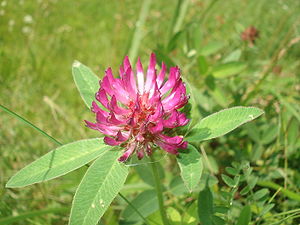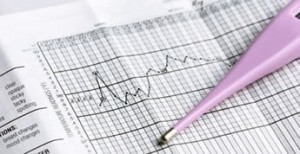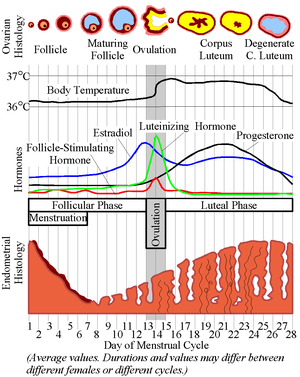
- Red Clover Image via Wikipedia
Many women respond to single herbs or single formulas in their quest to get pregnant. A strong overnight infusion of red clover, or red clover mixed with nettles and oatstraw has pushed many women over the brink from infertility to fertility. This seems to work best when a little extra nourishment is needed in an otherwise healthy woman. But hormones are complex, and the reasons why they may be out of balance are varied.
But before giving targeted formulas , the first thing I suggest to women is that they check their nutrition. While I believe that women with a variety of fruits, vegetables and meat in their diets probably do not need to supplement most vitamins, minerals are another thing entirely. Between the mid 1970s and mid 1990’s the USDA tested the nutritional content of food and found most minerals declined by a third due to soil depletion. Magnesium is one of the most important, but zinc, boron and a number of trace minerals are also significant. I suggest at least 500mg of magnesium plus a multi-mineral or trace concentrate supplement. Fish oil sufficient to provide 1000mg of DHA (several capsules) will help keep the cell membranes of your egg responsive to the sperm. Vitamin D is not really a vitamin, but a pro-hormone and you probably need 5000-10,000 iu (a quarter to half of a physiological sun dose.) If you live north of Atlanta, are fat, have diabetes or have dark skin, you probably need more. Folic acid is very important to prevent birth defects and is found in a good quality prenatal formula which you should take in anticipation of getting pregnant.
It is important to know how to use herbs for fertility since there are so many causes. Missing minerals, insulin resistance, lack of essential fats, lack of protein, strong fears of motherhood or pregnancy, low quality menstrual cycles, silent infections like chlamydia or gonorrhea, blocked fallopian tubes, PCOS, aging eggs and sperm, and many other factors affect fertility and the remedies are all different.
The menstrual cycle has clearly defined parts as you can see on the bottom of this article (click to enlarge). The first part of the cycle, from bleeding to ovulation is ruled by Yin and is characterized by climbing estradiol (one of the estrogens) which rises to spike just before ovulation. That is followed by short spikes in FSH and LH during ovulation, which trigger progesterone for the Yang luteal phase. The pattern must be balanced to have enough Yin for a high estrogen spike, to have a good temperature differentiation between the Yin and Yang phases of the cycle and to have a high enough transition to allow the egg to be released.

How would you tell if your menstrual cycle is not well balanced? In Chinese medicine we always normalize the menstrual cycle of the woman to get her pregnant. I find that it is easier to get pregnant if you actually follow your cycle by charting your basal body temperature and check your cervical mucous. To do this you keep a basal body thermometer (a digital thermometer that has an extra decimal place) by your bed and take your temperature before you start moving around. You plot the temperature on some graph paper or a chart You can find instructions for taking your temperature and making a chart here. Typically you see a low fairly steady temperature until about 12 days after you start menstruating. The temperature dips slightly, spikes high at ovulation and finishes higher. You can see an example on the chart at the bottom of the page, in the second band.
The chart is often used by women to decide when to have intercourse (just before and after ovulation) but a skilled practitioner can use it to choose herbs and to rebalance the cycle. For instance if the temperature is sawtooothed there may be Liver Qi Stagnation and herbs to move the liver and release emotions may stabilize it. The follicular (Yin, estrogen) phase may be too short or the luteal (Yang, progesterone) phase too long, so you may tonify Yin with herbs like rhemannia. The ovulation spike may occur but not be high enough to actually release the egg and vitex may be helpful. The progesterone phase may not produce a high enough temperature to prevent miscarriage so Yang tonics like walnuts and red meat are needed. The entire cycle may be too short or too long. Different herbs would be selected for different conditions and for different constitutional types.

There are many reasons to consider giving different formulas during different phases of the menstrual cycle in order to enhance fertility. A simple way is to give Yin-tonifying herbs (with a touch of Yang) from menstruation to ovulation (the follicular phase) and Yang tonifying herbs during the luteal phase. Typically the Yin tonifying formula Rhemannia 6 (Liu wei di huang wan) is given up until ovulation and a pregnancy-safe version of the Yang tonifying formula Rhemannia 8 (Jin gui shen qi wan) post ovulation. The formulas are identical except that the yang tonifying formula has two extra warming herbs and they can be mixed and matched for partial conditions. Sometimes a third formula will be given during the few days of ovulation, especially if there is a FSH or LH defect in the cycle.
However a woman goes through more than two different hormonal processes during her menstrual cycle. In the first phase she ripens the egg and builds the endometrium in her womb, which depends upon Kidney Yin and Blood. In the second , Liver Q and Blood movement govern ovulation. In the third phase Kidney Yang and Spleen Qi regulate the luteal stage or hold the pregnancy if it occurs. In Phase 4, when PMS is most prevalent, Liver Qi helps the premenstrual transformation. And Phase 5 is menstruation, covered by Blood and a little Qi to keep it moving.
It is not necessary to come up with five formulas unless the cycle is seriously disturbed. If only one part of the cycle is not functioning well, you can target it. This is not only done by, say giving vitex which increases progesterone during the luteal phase. Instead I might use magnesium and zinc throughout the cycle as these help the body form progesterone itself. Or I might add a little warming cinnamon and maca to the Yin phase of the formula in order to give the yin enough oomph to transform to yang at ovulation.
Menstrual Phases and Herbs
Phase |
|
Ruled By |
Supportive Herbs |
Lifestyle |
|||||
|
|
|||||||||
Follicular |
Kidney Yin | Rhemannia | Sleep | ||||||
| Blood | Goji berries | Nourishing conditions | |||||||
| Slippery elm | Water | ||||||||
| Peony root | Walks by Streams | ||||||||
| Black sesame seeds | Dark red and green foods | ||||||||
| Seaweeds | Black and Blue Foods | ||||||||
| Shatavari (Asparagus root) | Gelatinous foods | ||||||||
| Dang gui (Chinese angelica) | Black beans, kidney beans | ||||||||
| Butter | |||||||||
| Nuts, seeds | |||||||||
Ovulation |
Liver Qi | Milk thistle | Aerobic exercise | ||||||
| Blood | Chai hu (bluperum) | Sexual activity | |||||||
| Goji berries | Expressing emotions | ||||||||
| Peony root | Beet greens | ||||||||
| Damiana | Butter | ||||||||
Luteal |
Kidney Yang | Black beans | Warm baths | ||||||
| Spleen Qi | Cinnamon | or Maca | Avoiding chills or cold food | ||||||
| Dried ginger l | Red meat | ||||||||
| Walnuts | Yellow, orange and black foods | ||||||||
| Yams | Carrot juice | ||||||||
| Vitex | Magnesium | and zinc | |||||||
Premenstrual |
Liver Qi | Free and Easy Wanderer | Movement | ||||||
| (Xiao yao san) | Expressing emotions | ||||||||
| Cilantro | Walks in green forests | ||||||||
| Licorice | |||||||||
Menstrual |
Blood | Topical frankincense | Warmth | ||||||
| San qi (notoginseng) | Moonlight walks by sea | ||||||||
| Turmeric | Mild movement | ||||||||
| Rest | |||||||||
| Beets | |||||||||

- Image via Wikipedia
Now normally I wouldn’t go for simple herbs given as examples in the chart above. I give herbs in formulas that are individualized for the client. The client may have a pattern of phlegm or dampness or yin deficiency which would need addressing in all stages. In formulas for all stages I would probably include an appropriate adaptogen to balance the HPA-Ovarian axis like ginseng or shatavari or eleuthero. The body will do better overall if its own balancing is engaged rather than being just pushed, but since women tend to come to me towards the end of their reproductive cycle, I don’t rely upon adaptogens alone.
I may use Yang-supporting herbs during the Yin phase since Yin engenders Yang. And I never tonify Yang without also tonifying Yin. If you look at the chart on the right you see that there is some level of progesterone during the follicular, estrogen-dominant phase and quite a bit of estrogen during the progesterone-dominant luteal phase. (This fits Yin/Yang theory quite well.)
The other reason for staging formulas is that certain formulas useful for fertility may be contraindicated in pregnancy. For instance if a woman has blocked fallopian tubes or phlegm stasis PCOS, I would want to use herbs that would be too strongly moving to be used in pregnancy. The best way to do this is to have the woman use a barrier method of birth control for two to three cycles. However in women who fear that they have few cycles left, we may only give the formula up until ovulation then stop during the time that she might get pregnant, starting up again as menstruation begins.
Women are cyclic creatures, with hormonal tides. It makes sense that we follow those tides when treating herbally, ensuring that there is enough Yin, Yang, Jing and Blood to support a healthy pregnancy. And staging herbal formulas to support those tides can give a woman what she needs to nourish a healthy baby.
that there is enough Yin, Yang, Jing and Blood to support a healthy pregnancy. And staging herbal formulas to support those tides can give a woman what she needs to nourish a healthy baby.
Related articles :
- Charting Cervical Mucus to Achieve Pregnancy (family-planning.suite101.com)
- How To Use Natural Birth Control (lifescript.com)
- Full Fat Dairy Helps Ovulation in the Infertile (acupuncturebrooklyn.com)
- Herbs for Sex and Sexual Response (acupuncturebrooklyn.com)
- Insulin Resistance and Infertility (acupuncturebrooklyn.com)
- Endometriosis and Chinese Medicine (acupuncturebrooklyn.com)


